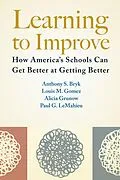As a field, education has largely failed to learn from experience. Time after time, promising education reforms fall short of their goals and are abandoned as other promising ideas take their place. In Learning to Improve, the authors argue for a new approach. Rather than "implementing fast and learning slow," they believe educators should adopt a more rigorous approach to improvement that allows the field to "learn fast to implement well."
Using ideas borrowed from improvement science, the authors show how a process of disciplined inquiry can be combined with the use of networks to identify, adapt, and successfully scale up promising interventions in education. Organized around six core principles, the book shows how "networked improvement communities" can bring together researchers and practitioners to accelerate learning in key areas of education. Examples include efforts to address the high rates of failure among students in community college remedial math courses and strategies for improving feedback to novice teachers.
Learning to Improve offers a new paradigm for research and development in education that promises to be a powerful driver of improvement for the nation's schools and colleges.
Autorentext
Klappentext
Using ideas borrowed from improvement science, the authors show how a process of disciplined inquiry can be combined with the use of networks to identify, adapt, and successfully scale up promising interventions in education. Organized around six core principles, the book shows how "networked improvement communities" can bring together researchers and practitioners to accelerate learning in key areas of education. Examples include efforts to address the high rates of failure among students in community college remedial math courses and strategies for improving feedback to novice teachers.
Learning to Improve offers a new paradigm for research and development in education that promises to be a powerful driver of improvement for the nation's schools and colleges.
Inhalt
Contents
Preface ix
Introduction 1
A Better Way
Make the Work Problem-Specific and User-Centered 21
Focus on Variation in Performance 35
See the System That Produces the Current Outcomes 57
We Cannot Improve at Scale What We Cannot Measure 87
Use Disciplined Inquiry to Drive Improvement 113
Accelerate Learning Through Networked Communities 141
Living Improvement 171
Glossary 195
Appendix 203
Responses to Some Frequently Asked Questions
Notes 211
Acknowledgments 243
About the Authors 247
Index 251
